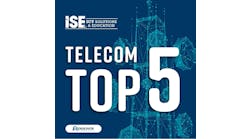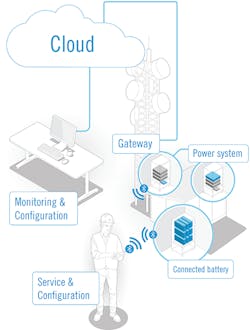Latest from Home
Hybrid Powering and IoT Management for the Future:
The need for communication is continuously growing, with the ICT industry leading the way to provide mobility and connectivity. This development, however, is facing 2 major challenges: securing powering of telecom sites, and a smooth move from fossil to renewable energy. The key factor to meet these challenges is smart backup solutions — such as the connected battery.
The fastest growth, but also greatest difficulties, is found in developing regions. Poor and unreliable power grids, in combination with remote, inaccessible telecom sites, pose a challenge for the continued development of the communication infrastructure in regions, such as rural parts of Asia and Africa. Locally produced renewable energy and continuous control of the power solution are 2 key parameters to ensure communication in these remote regions. These parameters also apply to improving and securing network operations in mature markets.
Harsh Realities Today, there are between 2-3 billion smartphone users in the world (expected to rise to 5-6 billion by 2020*). They are connected through an estimated 3.3 million telecom towers around the world. About one third of these are in remote areas, and a majority of the next millions of telecom tower sites will most likely be set up in regions with limited infrastructure.
This poses a challenge for reliability short-term, but also for long-term, sustainability. As remote regions, often have non-existing or unreliable power grids, the access to power is essential to keep communication up and running. The demands on cost efficiency and reduced environmental impact will continue to increase also in these regions.
Telecom Challenge #1: Making operation more efficient and secure
To have a network up and running is not only a matter of keeping critical communication under control, or satisfying peoples’ needs for communication in general. To telecom companies, every outage is lost revenue and possible bad will. Every minute of downtime is a minute of lost fees from subscribers.
Besides the problems with poor infrastructure and difficult logistics to serve remote locations, the limited options in back-up power solutions is costing telecom operators money for 2 reasons.
Factor A: It is quite difficult to install batteries correctly in telecom tower sites, with customized power settings — especially if the service technician lacks specific skills for this. Installation of unhealthy batteries or using the wrong power settings dramatically reduces the life expectancy of the batteries. Reduced service life means increased replacement costs both for the battery itself, and for delivery and installation. Furthermore, a battery which fails unexpectedly can cause downtime on telecom sites and hence dramatic revenue losses.
Factor B: To prevent unexpected battery failure, telecom operators often schedule a replacement much earlier than necessary. From their vantage point, it is better to take on the cost of not using the battery till end of life, than risk a power outage. Better energy management, however, could potentially save up to 700 million USD per year just by making better and more efficient use of their batteries. In addition, continuous monitoring improves site stability with reduced outage time, which saves even more OpEx.
Telecom Challenge #2: Making a profitable move from fossil to renewable energy
In developing regions a great number of the remote telecom sites are powered by diesel generators. These sites run more or less continuously, consuming diesel oil by the barrel. A service technician is needed for frequent visits to refuel and to monitor them. This is an expensive solution, but is often the only viable alternative to keep networks up and running.
With hybrid power solutions, partially powered by renewable energy sources such as solar or wind, the main energy source can be shifted from diesel to renewable energy. In this option, diesel generators are used only to top off the energy need. The savings in replacing diesel with renewable energy is not only a good solution for the environment, but also contributes to great savings in operational costs for the operator. Oftentimes, the investment in renewable energy is paid back in a very short time.
In addition, remotely managed batteries can enable hybrid power solutions to run without the need for frequent service visits. With the energy being locally produced, and the site status monitored 24/7, the savings for telecom operators can be significant.
Bringing IoT to Energy Storage
A megatrend in society in general is digitalization of processes, by capturing, transferring, and analyzing data through Internet of Things (IoT) technology. Wherever there is a process with data and an inefficiency, IoT can improve the process, and help owners to make better and quicker decisions.
This trend now reaches into the backup power of telecom sites. With a continuous stream of data from batteries securely connected to a Cloud service, authorized operators are able to monitor their power situation at individual sites, at anytime from anywhere. This enables better planning and improved efficiency through earlier alarms and fact-based decisions on battery replacement. Remote monitoring also helps operators to plan and decide when a technician is needed at a remote site, when it’s time to order new batteries, or when to quickly act on power outages. All this enables great savings in operating costs for the telecom operators.
Furthermore, a "talking" battery can communicate its health and status to a nearby smart phone, and help guide to a correct installation.
Today batteries are used to store energy in the ICT industry. However, they are often managed ineffectively. As a result, the demand for intelligent energy storage will rapidly increase in the near future.
One solution that addresses these things is NorthStar ACE™. It combines Bluetooth communication with an IoT concept. The user can retrieve real time and historical performance data wirelessly, both locally through a smartphone app and remotely through a Cloud service. The batteries are managed from manufacturing throughout the life of the product.
‘With solutions such as these, ICT providers are able to both predict the end of life for site batteries while also optimizing maintenance procedures.
Continuous monitoring and control over each individual telecom site without setting foot on site, together with locally generated, renewable energy, may be the 2 biggest opportunities ahead for telecom operators to meet the challenges with reliability and sustainability of their remote telecom sites.
Sources:
*Ericsson Mobility report 2015
*https://techcrunch.com/





